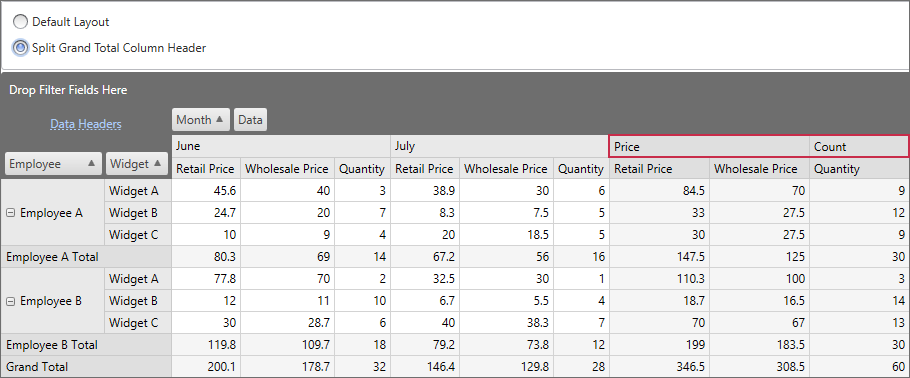PivotCustomFieldValueCellsEventArgs.Split(Boolean, Predicate<FieldValueCell>, IList<FieldValueSplitData>) Method
Splits all field value cells that match the specified condition.
Namespace: DevExpress.Xpf.PivotGrid
Assembly: DevExpress.Xpf.PivotGrid.v25.2.dll
NuGet Package: DevExpress.Wpf.PivotGrid
Declaration
public void Split(
bool isColumn,
Predicate<FieldValueCell> match,
IList<FieldValueSplitData> cells
)Parameters
| Name | Type | Description |
|---|---|---|
| isColumn | Boolean |
|
| match | Predicate<FieldValueCell> | A System.Predicate that represents the condition used to define which cells should be split. |
| cells | IList<FieldValueSplitData> | A list of FieldValueSplitData objects that define how to split the cells. |
Remarks
The Split method cannot split a field value cell if it has only one nested cell, or has none.
To split a cell (or several cells), create a System.Predicate<FieldValueCell> delegate that defines which cells should be split, and pass it as the match parameter. You should also create a list of FieldValueSplitData objects. Each of them identifies a single new cell, from the leftmost to the rightmost (for the column cells), or from the topmost to the bottommost (for the row cells). Specify the size and values of the new cells using the FieldValueSplitData.NestedCellCount and FieldValueSplitData.Value properties, respectively, and pass the list as the cells parameter. The FieldValueSplitData.NestedCellCount property defines the size of a newly created cell by specifying the number of cells nested in it.

This overload of the Split method splits all cells that match the specified condition. To split only the first matching cell, use another overload that takes the firstCellOnly parameter (set it to true).
Example
The following example demonstrates how to split field value cells. In this example, the Grand Total column header is split into two cells: Price and Count.

Handle the CustomFieldValueCells event and call the event parameter’s Split method. Cells that should be split are identified by a predicate that returns true for those cells. The quantity, size, and captions of newly created cells are specified by an array of cell definitions (the FieldValueSplitData objects).
<Window xmlns:dxpg="http://schemas.devexpress.com/winfx/2008/xaml/pivotgrid"
xmlns="http://schemas.microsoft.com/winfx/2006/xaml/presentation"
xmlns:dx="http://schemas.devexpress.com/winfx/2008/xaml/core"
xmlns:x="http://schemas.microsoft.com/winfx/2006/xaml"
x:Class="DXPivotGrid_SplittingCells.Window1"
dx:ThemeManager.ThemeName="LightGray"
Height="580" Width="1200"
Loaded="Window_Loaded"
Title="Window1">
<Grid>
<Grid.RowDefinitions>
<RowDefinition Height="Auto" />
<RowDefinition Height="*" />
</Grid.RowDefinitions>
<dxpg:PivotGridControl Grid.Row="1" Margin="2,2,2,0" Name="pivotGrid" AllowDrag="False"
FieldValueDisplayText="pivotGrid_FieldValueDisplayText"
AllowFilter="False" DataProcessingEngine="Optimized"/>
<GroupBox Grid.Row="0" Height="Auto" Margin="2,2,2,0"
Name="groupBox1" VerticalAlignment="Bottom">
<StackPanel Orientation="Vertical">
<RadioButton x:Name="rbDefault" IsChecked="True" Content="Default Layout"
Margin="0,0,0,2" Checked="rbDefault_Checked"/>
<RadioButton Checked="rbDefault_Checked" Margin="0,2,0,0"
Content="Split Grand Total Column Header"/>
</StackPanel>
</GroupBox>
</Grid>
</Window>
using System;
using System.Collections.Generic;
using System.Globalization;
using System.Windows;
using DevExpress.Xpf.PivotGrid;
using DevExpress.XtraPivotGrid.Data;
namespace DXPivotGrid_SplittingCells {
public partial class Window1 : Window {
public Window1() {
InitializeComponent();
pivotGrid.CustomFieldValueCells +=
new PivotCustomFieldValueCellsEventHandler(pivotGrid_CustomFieldValueCells);
}
void Window_Loaded(object sender, RoutedEventArgs e) {
PivotHelper.FillPivot(pivotGrid);
pivotGrid.DataSource = PivotHelper.GetDataTable();
pivotGrid.BestFit();
}
void pivotGrid_CustomFieldValueCells(object sender, PivotCustomFieldValueCellsEventArgs e) {
if (pivotGrid.DataSource == null) return;
if (rbDefault.IsChecked == true) return;
// Creates a predicate that returns true for the Grand Total
// headers, and false for any other column/row header.
// Only cells that match this predicate are split.
Predicate<FieldValueCell> condition =
new Predicate<FieldValueCell>(delegate(FieldValueCell matchCell) {
return matchCell.ValueType == FieldValueType.GrandTotal &&
matchCell.Field == null;
});
// Creates a list of cell definitions that represent newly created cells.
// Two definitions are added to the list. The first one identifies
// the Price cell, which has two nested cells (the Retail Price and Wholesale Price
// data field headers). The second one identifies the Count cell with
// one nested cell (the Quantity data field header).
List<FieldValueSplitData> cells = new List<FieldValueSplitData>(2);
cells.Add(new FieldValueSplitData("Price", 2));
cells.Add(new FieldValueSplitData("Count", 1));
// Performs splitting.
e.Split(true, condition, cells);
}
void pivotGrid_FieldValueDisplayText(object sender, PivotFieldDisplayTextEventArgs e) {
if(e.Field == pivotGrid.Fields[PivotHelper.Month]) {
e.DisplayText = CultureInfo.CurrentCulture.DateTimeFormat.GetMonthName((int)e.Value);
}
}
private void rbDefault_Checked(object sender, RoutedEventArgs e) {
pivotGrid.LayoutChanged();
}
}
}